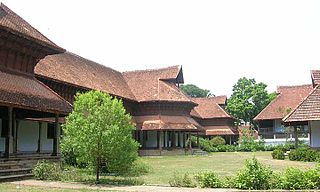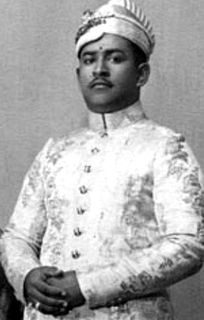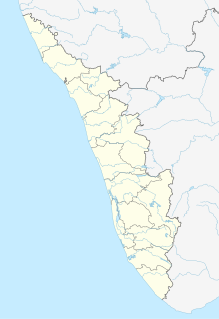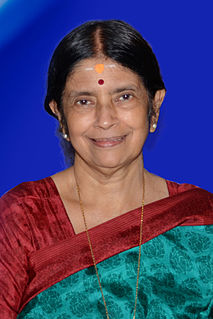
The Kingdom of Travancore was an Indian kingdom from c. 1729 until 1949. It was ruled by the Travancore Royal Family from Padmanabhapuram, and later Thiruvananthapuram. At its zenith, the kingdom covered most of modern-day southern Kerala, parts of central Kerala, and the southernmost part of modern-day Tamil Nadu with the Thachudaya Kaimal's enclave of Irinjalakuda Koodalmanikyam temple in the neighbouring Kingdom of Cochin.

Sree Padmanabhadasa Sree Chithira Thirunal Balarama Varma, popularly known as Sree Chithira Thirunal, was the last ruling Maharaja of the Princely State of Travancore, in southern India until 1949 and later the Titular Maharajah of Travancore until 1991. Sree Chithira Thirunal was the eldest son of Junior Maharani of Travancore, H.H. Sree Padmanabhasevini Vanchidharmavardhini Rajarajeshwari Maharani Moolam Thirunal Sethu Parvathi Bayi, and Sri Pooram Nal Ravi Varma Koyi Thampuran of the Royal House of Kilimanoor. He was privately educated, and became the Maharajah of Travancore, at the age of 12, upon the death of his maternal great uncle, the then Maharajah of Travancore Sree Moolam Thirunal, on 7 August 1924. He reigned under the regency of his maternal aunt, Sethu Lakshmi Bayi (1924–31), until he came of age and was invested with full ruling powers on 6 November 1931.

Anizham Thirunal Marthanda Varma ; 1706 – 7 July 1758, known as the Maker of Modern Travancore, was ruler of the Indian kingdom of Travancore (Venadu) from 1729 until his death in 1758. He was succeeded by Rama Varma (1758–98).

University of Kerala, formerly the University of Travancore, is an affiliating university located in Thiruvananthapuram, capital of the state of Kerala, India. It was established in 1937, long before the birth of the state of Kerala India, by a promulgation of the Maharaja of Travancore, Chithira Thirunal Balarama Varma who was also the first Chancellor of the university: C. P. Ramaswami Iyer
The Temple Entry Proclamation was issued by Maharaja Chithira Thirunal Balarama Varma on November 12, 1936 and abolished the ban on the so-called 'low caste people' or avarnas from entering Hindu temples in the Princely State of Travancore, now part of Kerala, India.

Ārāttu is a ritual performed at many of the Hindu temple festivals in Kerala, India. In ārāttu, a priest takes the idol of the deity and bath it in a river or temple tank. It is mainly carried out at the end of the festival of the temple. Ārāttu is celebrated twice annually, in the spring festival and the autumn festival. Festivals are normally 10 days long.

The Padmanabhaswamy temple is a Hindu temple located in Thiruvananthapuram, the state capital of Kerala, India. The name of the city of Thiruvananthapuram in Malayalam translates to "The City of Lord Ananta", referring to the deity of the Padmanabhaswamy temple. The temple is built in an intricate fusion of the Chera style and the Dravidian style of architecture, featuring high walls, and a 16th-century gopura. While the Ananthapura temple in Kumbla is considered the original seat of the deity ("Moolasthanam"), architecturally to some extent, the temple is a replica of the Adikesava Perumal temple in Thiruvattar.

The Adikesavaperumal Temple is a Hindu temple located in Thiruvattar, Kanyakumari district, Tamil Nadu, India and is one of the 108 Divya desams, the holy sites of Hindu Vaishnavism according to existing Tamil hymns from the seventh and eighth centuries C.E. The temple is one of the historic thirteen Divya Deshams of Malai Nadu. The temple is a picturesque setting surrounded on three sides by rivers namely, It was the Rajya Temple and Bharadevatha shrine of Erstwhile Travancore. After state reorganisation, the temple handed over to Tamilnadu H&RCE Dept. The presiding Vishnu in the form of Ananthapadmabhan/Adikeshavaperumal is believed to be older than Padmanabhaswamy Temple in Thiruvananthapuram. Since Vishnu resides here in a reclining position, and is surrounded by rivers, the temple is called as "The Srirangam of Chera Kingdom".
The history of Thiruvananthapuram dates back to the 10th century AD. The city and several other places in the district occupy an important place in ancient tradition, folklores and literature of the State of Kerala.

Pooradam Thirunal Sethu Lakshmi Bayi CI (1895–1985) was the monarch, though designated as the Regent due to the British policy, of the Kingdom of Travancore in southern India between 1924 and 1931. She, along with her younger cousin, Moolam Thirunal Sethu Parvathi Bayi, were adopted into the Travancore Royal Family and were the granddaughters of the celebrated painter, Raja Ravi Varma.

Kuthiramalika is a palace built by Swathi Thirunal Rama Varma on the south-eastern side of Padmanabhaswamy temple, Thiruvananthapuram.

Sree Padmanabhadasa Sree Uthradom Thirunal Marthanda Varma was the titular Maharaja of Travancore. He was the younger brother of the last ruling monarch of the Kingdom of Travancore, Maharajah Chithira Thirunal Balarama Varma.

Thrikkovil - Sree Padmanabhaswamy temple, is a Hindu temple with Lord Vishnu as the presiding deity, located at Vallicode village in Pathanamthitta District in Kerala, India.

The Travancore royal family was the ruling house of the Kingdom of Travancore. They lost their ruling rights in 1949 when Travancore merged with India and their remaining privileges were abolished in 1971. The family are descended from the Ay/Venad family, Cheras, Pandyas and Cholas. The ruler in that bloodline was Maharaja Sree Moolam Thirunal, as the family of Maharaja Chithira Thirunal and successors.
Konattu Madam Chidambara Iyer Subrahmania Iyer, known better as K. C. S. Mani, was a socialist activist of Kerala who is known for his attempt of assassination on C. P. Ramaswamy Iyer, the then Diwan of Travancore, a princely state in India. This incident was a turning point in the history of Kerala, forcing the Diwan to leave Travancore and flee to Madras after assenting to merge Travancore with the Union of India.

The Mithrananthapuram Trimurti Temple is a temple complex in Kerala, India. Mithrananthapuram Thrimoorthy Temple is a temple in Kerala where devotees can worship all the Trimurtis. Temple is located on the western side of Sri Padmanabhaswamy temple in Thiruvananthapuram.

Sree Padmanabhadasa Sree Moolam Thirunal Rama Varma is the current titular Maharajah of Travancore. He is the youngest of the four children of the former Titular Maharani of Travancore, H.H. Sree Padmanabhasevini Maharani Karthika Thirunal Lakshmi Bayi and her husband, Prince Consort Lt. Col. G. V. Raja of Poonjar Royal House.

Aswathy Thirunal Gowri Lakshmi Bayi of the former Travancore Royal Family is a noted writer from Kerala. She has ten books to her credit.

Parassala B. Ponnammal is an Indian Carnatic musician. On 23 September 2006, she sang at the Navaratri Mandapam in Trivandrum, breaking 300 years of tradition that forbade women from performing at or attending the famed Navaratri Celebrations of the Sri Padmanabhaswamy temple in Kerala.This was made possible by Prince Rama Varma of the Travancore Royal Family.















